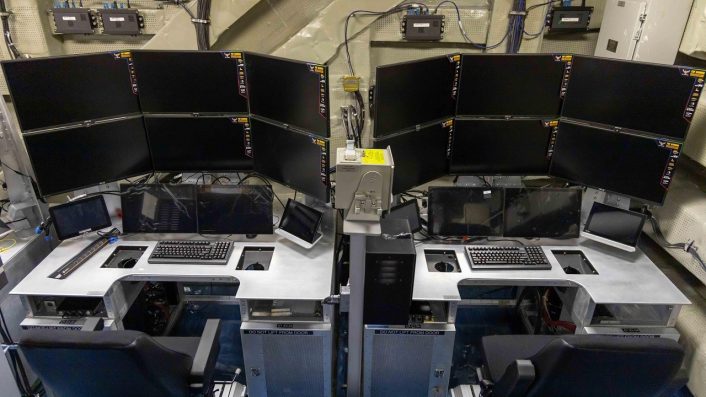The UAWC, which the USS Bush will test early next year, will allow the aircraft carrier to include the MQ-25 Stingray and other unmanned assets in its flight operations.
Th U.S. Navy has recently installed the first Unmanned Air Warfare Center (UAWC) aboard USS George H.W. Bush (CVN 77). The UAWC will be used by Air Vehicle Pilots (AVPs) to control the MQ-25 Stingray during airborne operations, as well as future unmanned platforms.
In a press release on Aug. 15, 2024, NAVAIR (Naval Air Systems Command) said the installation was a multi-year effort coordinated across multiple ship availability periods and the ship’s deployment schedule. Early next year, the USS Bush will be employed for the first at-sea testing of the UAWC’s operational networks.
“CVN 77’s UAWC lays the foundation for how the U.S. Navy will operate and control unmanned aircraft, and perhaps other unmanned vehicles, with UMCS,” said Unmanned Carrier Aviation (PMA-268) Program Manager Capt. Daniel Fucito. “These systems will initially support the MQ-25 but also future unmanned systems such as Collaborative Combat Aircraft that comprise the Air Wing of the Future.”
The UAWC
The Unmanned Air Warfare Center will act as a carrier-based control room for the unmanned platforms which will integrate in the future Carrier Air Wing. The UAWC includes software and hardware systems that make up the first fully operational and integrated Unmanned Carrier Aviation Mission Control System (UMCS) MD-5E Ground Control Station (GCS).
UMCS is the system-of-systems required for the MQ-25 air vehicle command and control and is critical to the unmanned aircraft refueler’s operations. The GCS was developed by the Navy and integrates the Multi Domain Combat System (MDCX) developed by Lockheed Martin’s Skunk Works, along with additional supporting equipment and hardware.
U.S. Navy installs the first Unmanned Air Warfare Center, integrating advanced command and control for the Navy’s Air Wing of the Future by Lockheed Martin Skunk Works® MDCX™ Multi-Domain Combat System. 🔗
— Lockheed Martin News (@LMNews) August 15, 2024
The hardware installed in the racks and cockpits is the baseline for the production systems currently being fabricated for installation on CVNs 70, 71, and 76 beginning in fiscal year 2025, says NAVAIR. Earlier this year, a simulated GCS was used on the USS Abraham Lincoln to perform initial network testing, informing the continuation of the work, but the next round of testing will be on the actual system.
“This will be the first time the AVPs from Unmanned Carrier-Launched Multi-Role Squadron (VUQ) 10 will operate the MD-5 from an aircraft carrier. They will use the actual GCS hardware and software aboard CVN 77 to communicate with a simulated air vehicle in the lab in Pax River,” said Joe Nedeau, PMA-268 UMCS lead.
PMA-268 is the lead systems integrator for the MQ-25, working closely with its two prime industry partners, Boeing and Lockheed Martin, to seamlessly integrate the MQ-25 into carrier operations, including deck handing, taxiing and launch and recovery.

The MQ-25 Stingray
The Boeing MQ-25 Stingray is an aerial refueling drone that resulted from the Carrier-Based Aerial-Refueling System (CBARS) program, which grew out of the earlier Unmanned Carrier-Launched Airborne Surveillance and Strike (UCLASS) program.
The genesis of the MQ-25 Stingray traces back to the U.S. Navy’s imperative for a carrier-based unmanned aerial vehicle (UAV) capable of providing aerial refueling to carrier strike groups’ assets. The primary mission of the MQ-25 is to deliver on-demand refueling support, significantly extending the endurance and operational flexibility of carrier-based aircraft.
The MQ-25 Stingray carried out the first ever air-to-air refueling operation between an unmanned tanker and a manned receiver aircraft, (a U.S. Navy F/A-18F Super Hornet) on June 4, 2021. The milestone was achieved by the Boeing-owned MQ-25 T1 test asset flying from MidAmerica Airport in Mascoutah (Illinois) and employing the Cobham Aerial Refueling Store (ARS), the same used by F/A-18s, to perform the refueling operation.
The U.S. Navy is planning to procure more than 70 MQ-25, which will replace the F/A-18E Super Hornets in the aerial refueling role they currently have as part of the Carrier Air Wing, becoming also the first operational carrier-based UAV. This way, the Carrier Air Wing will have more Super Hornets available for operational missions, without the need to reserve some of them for the AAR (Air-to-Air Refueling) mission.
“MQ-25 increases the overall lethality of the CVW by relieving the F/A-18E/F Super Hornet of the aerial refueling mission, enabling ordnance to replace refueling stores on the F/A-18’s pylons. As secondary missions, MQ-25 will conduct recovery tanking and organic intelligence, surveillance and reconnaissance (ISR) to the CSG,” says the website of Unmanned Carrier-Launched Multi-Role Squadron Ten (VUQ-10), the Fleet Replacement Squadron (FRS) for the MQ-25 Stingray, established on Oct. 01, 2022, at Naval Air Station Patuxent River, Maryland.
In addition to VUQ-10, two operational MQ-25A squadrons, VUQ-11 and 12, will be established. Earlier this year, Boeing showcased a new software that allows F/A-18 pilots to control the MQ-25 during the air refueling operations, as part of the development of the manned-unmanned teaming (MUM-T) technology.

